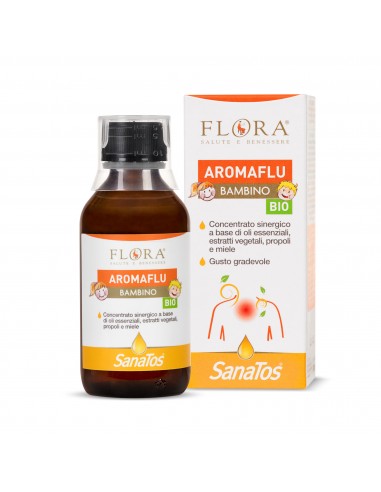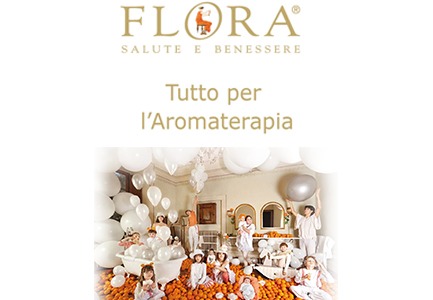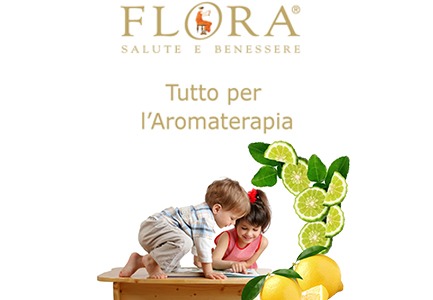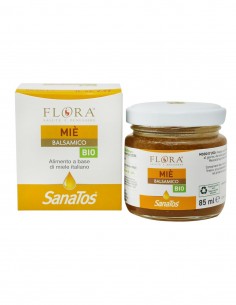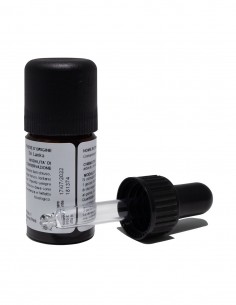Child Aromaflu is a food supplement, a synergistic concentrate based on 100% pure essential oils, plant extracts, propolis and honey.
Dwarf mint 100% pure essential oil promotes a balsam effect as well as a healthy nose and throat, while fennel essential oil is helpful in promoting fluid bronchial secretions.
The plant extracts of grindelia, echinacea, and mallow together with 100% pure cajeput essential oil facilitates respiratory tract function.
In addition, the plant extracts of grindelia and mallow have an emollient and soothing effect on oropharyngeal mucosa, and the tone of the voice, while echinacea and acerola cherry support the body's natural defences.
- Properties
- Fluidifying and soothing
- Form
- 100 ml
- Expiry
- 36 months from date of manufacture
- Does not contain
- Dyes, preservatives, synthetic substances
8019359022375
- Children from 3 to 8 years of age _ recommended dosage 2.5 ml 2-3 times daily
- Children from 8 years of age _ 5 ml 2-3 times a day is recommended
Child Aromaflu – food supplement concentrate can be taken pure, or diluted in water, fruit juices, herbal teas, etc. SHAKE BEFORE USE. The possible presence of suspensoids is due to the high concentration of active substances, and in no way affects the effectiveness of the food supplement. Food supplements should not be used as a substitute for a varied, balanced diet and a healthy lifestyle. In the event of inappropriate ingestion, do not induce vomiting and consult a doctor immediately. Keep out of reach of children under 3 years of age. Propolis may cause allergic reactions in rare cases. Do not exceed the recommended daily dose. Keep the bottle tightly closed, in a cool, dry place and away from light. Always store carefully in its container. The expiry date refers to the product correctly stored in unopened packaging. After opening store in the refrigerator.
CHARACTERISTIC INGREDIENTS PER MAXIMUM DAILY DOSE – 15 ml
- propolis (Propolis) 0.195 g
- echinacea (Echinacea angustifolia, H.) 0.59 g
- acacia honey (Mel) 7.835 g
- fennel (Foeniculum vulgare M.) 0.02 g
- orange (Citrus aurantium L. var. dulcis) 0.025 g
- cajeput (Melaleuca leucadendron L. var. cajaputi) 0.02 g
- dwarf mint (Mentha spicata, L.) 0.05 g
- cinnamon (Cinnamomum zeylanicum, G.) 0.01 g
- fructose 0.395 g
- malic acid 0.04 g
- grindelia (Grindelia robusta, N.) 0.59 g
- mallow (Malva sylvestris, L.) 0.59 g
- sage (Salvia officinalis, L.) 3.21 g
- wildflower honey (Mel) 5.85 g
- acerola cherry (Malpighia glabra, L.) 0.195 g
honey* 70% (Mel); sage** (Salvia officinalis, L.), leaves, hydrolate; grindelia* (Grindelia robusta, N.), flowers, glyceric extract; echinacea* (Echinacea angustifolia, H.) roots, glyceric extract; mallow* (Malva sylvestris, L.) flowers, glyceric extract; fructose; propolis* (Propolis resina), dry extract; acerola cherry* (Malpighia glabra L.) fruit, dry extract; cajeput* (Melaleuca leucadendron L. var. cajaputi) leaves, essential oil; dwarf mint* (Mentha spicata, L.) essential oil of all the plant ; cinnamon bark* (Cinnamomum zeylanicum, G.), essential oil of the bark ; sweet orange* (Citrus aurantium L. var. dulcis), essential oil of peel; fennel** (Foeniculum vulgare M.), essential oil of the seeds; malic acid. Ingredients are sourced from controlled organic* and Demeter biodynamic** farms.
Did you know that...
Propolis extract: the name propolis derives from the Greek πρόπολις, composed of πρό (pro) "in front of" and πόλις (polis) "city", i.e. "in front of the city"; this word, figuratively speaking, takes on the meaning of "defender of the city." The term was used by Aristotle and Pliny the Elder in ‘Naturalis Historia’ to refer to the resin processed by bees, who use it to defend their city (the hive) from dangers such as disease and predators. Propolis is one of the oldest used natural substances. As early as ancient Egypt, it was used for mummification (often referred to by the generic name of resin). In Ancient Greece (in the times of Aristotle, Galen of Pergamom and finally the Persian Avicenna), it was used externally as a healing agent for wounds or sores. The use of propolis is widely documented among numerous cultures around the world. The Incas used it to treat febrile illnesses, while in Russia it was a remedy for all problems of the oral cavity, used in cases of caries and inflammation. Propolis was one of the remedies of choice until the 18th Century, when it was used to treat respiratory inflammation, but also sores, insect bites, etc. It then fell into disuse, but has regained its value in the herbalism as a valid adjuvant to promote the functioning of the respiratory tract.
Echinacea extract: was already used by Native Americans and North American shamans for its many properties. It was considered to be a magic herb because it was used to treat wounds, burns, snake and scorpion bites, sore throats, and all colds. The traditional use of echinacea in the prevention of colds was gradually consolidated first in America (in the early 1900s it was one of the best-selling cold and flu medicines), and then in Europe, mainly in Germany, where it was known to 'switch off' cold and flu symptoms if taken early.
Grindelia extract: Native Americans use this plant as a cough suppressant, and to soothe throat irritations; this function was later taken up by the Jesuits and the first settlers who exported the plant to Europe, encouraging its spread. Grindelia is recognized for its properties in both American and French Pharmacopoeia. Currently, this plant is attributed an emollient and soothing action on oropharyngeal mucosa.
Mallow extract: thanks to its high mucilage content, it has an emollient effect, making the skin soft and moisturized, and an antioxidant effect, protecting the skin and mucous membranes.
Acerola cherry extract: contains up to 25% vitamin C. Many properties are traditionally linked to this vitamin, especially in preventing station sickness, and reducing the duration of winter problems. Our bodies are unable to synthesise it, and so it is necessary to ingest it either with food or by taking supplements.
Sage hydrolate: Sage is an aromatic herb whose use has been known since antiquity; there is evidence of its use in therapeutic practices by the Egyptians, Greeks and Romans. Its properties were numerous, so much so that its name derives from the Latin salvus, which means 'saved.' It was used as an anti-hemorrhagic, for washing and disinfecting ulcers and sores, and in cases of coughs and sore throats. This last function in particular has been handed down through tradition: it is no coincidence that our grandmothers gargled with water and sage, or with sage decoctions (or even chewed the leaves directly) in case of mouth inflammation.
Honey: For many centuries it has been used as a highly nutritional food; in recent years, ancient ways of using it are being rediscovered. In fact very ancient documents present honey as a powerful medicine. As early as 2000 BC there is evidence of honey being used as a medicine for external use. In the ‘Ebers Papyrus,’ dated 1550 BC, honey was used for many preparations, including those for eye health, for application to wounds and abscesses, and even following surgery (such as circumcision). Even the 'Surgical Papyrus,’ a papyrus on Egyptian medicine, mentions the use of honey as a wound dressing. In general, its use is found in all cultures where it is traditionally used for external use, but also for throat, respiratory and intestinal disorders.
Fennel essential oil: in addition to its well-known properties as an anti-meteoric and for combating flatulence, this essential oil is used for respiratory tract health.
Cajeput essential oil: Kaji-puti means "white tree" in Malay, indicating the white colour of the bark of the tree tops where this essential oil is obtained. Originally from Vietnam, it only arrived in the West in the 18th Century following the Dutch conquest of the Moluccas. In its native land, cajeput essential oil has always been used in folk medicine for therapeutic purposes, the indigenous used it for infections, from intestinal to skin, or burned the branches to ward off contagions during epidemics. The oil was traditionally used by rubbing it on the forehead to combat headaches, and ear and toothaches. It was also used to treat skin problems such as ulcers, acne and psoriasis.
Dwarf mint essential oil: Mint is one of the plants that have always played an important role, and to which numerous therapeutic and medicinal properties have been ascribed. The Egyptians and Greeks used it for its anti-nausea properties, and as a digestive aid. Pliny the Elder extolled its properties, saying that its fragrance was able to, "excite the soul and stimulate the appetite." The Salerno Medical School used it extensively as a vermifuge and even Pietro Andrea Mattioli, a herbalist from the 1500s wrote, "Mint has a certain bitterness in it, with which it kills worms". Its properties are so many and have always been appreciated that in the 11th Century Walahfried Strabo, a German abbot, theologian, and poet wrote: "If a man wanted to enumerate all the qualities, types and names of mint, he would also have to know how many fish swim in the Red Sea or how many thunderbolts Vulcan, the fire god of Lemnos, hurls into the air from the enormous mouth of Etna."
No reviews

